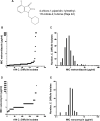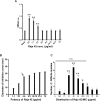Raja 42, a novel gamma lactam compound, is effective against Clostridioides difficile
- PMID: 34492076
- PMCID: PMC8423298
- DOI: 10.1371/journal.pone.0257143
Raja 42, a novel gamma lactam compound, is effective against Clostridioides difficile
Abstract
Clostridioides difficile infection (CDI) is the primary cause of hospital-acquired diarrhea, and responsible for over 500,000 enteric infections a year in the United States alone. Although most patients with CDI are successfully treated with metronidazole or vancomycin, the high rate of recurrence is still a serious problem, in which case these antibiotics are usually not very effective. The primary objective of this research is to develop a potentially effective therapeutic agent against C. difficile that are resistant to metronidazole or vancomycin. The susceptibility to metronidazole and vancomycin was examined with 194 C. difficile clinical isolates. Sixty of these isolates chosen based on a variety of criteria were examined for their susceptibility against the 4-chloro-1-piperidin-1ylmethyl-1H-indole-2,3-dione compound (Raja 42), a novel isatin-benzothiazole analogue containing a gamma-lactam structure, as we previously found that this novel compound is effective against a variety of different bacteria. Most of the 60 isolates were resistant to ceftriaxone and ciprofloxacin, raising the possibility that they might have been exposed previously to these or structurally similar antibiotics (e.g., β-lactam and quinolone compounds). Among the isolates, 48 (80%) and 54 (90%) were susceptible to metronidazole and vancomycin, respectively. Raja 42 was found to be effective against most of the isolates, especially so against metronidazole-resistant C. difficile. Most importantly, five isolates that show resistance to metronidazole and vancomycin were sensitive to Raja 42. Thus, Raja 42, a gamma lactam antibiotic, has the potential to effectively control C. difficile strains that are resistant to metronidazole and vancomycin.
Conflict of interest statement
The authors have declared that no competing interests exist.
Figures


Similar articles
-
Reassessment of Clostridium difficile susceptibility to metronidazole and vancomycin.Antimicrob Agents Chemother. 2002 Jun;46(6):1647-50. doi: 10.1128/AAC.46.6.1647-1650.2002. Antimicrob Agents Chemother. 2002. PMID: 12019070 Free PMC article.
-
The vanRCd Mutation 343A>G, Resulting in a Thr115Ala Substitution, Is Associated with an Elevated Minimum Inhibitory Concentration (MIC) of Vancomycin in Clostridioides difficile Clinical Isolates from Florida.Microbiol Spectr. 2023 Jun 15;11(3):e0377722. doi: 10.1128/spectrum.03777-22. Epub 2023 May 1. Microbiol Spectr. 2023. PMID: 37125917 Free PMC article.
-
Molecular epidemiology and antimicrobial susceptibility of human Clostridium difficile isolates from a single institution in Northern China.Medicine (Baltimore). 2018 Jun;97(25):e11219. doi: 10.1097/MD.0000000000011219. Medicine (Baltimore). 2018. PMID: 29924052 Free PMC article.
-
Progress on mechanisms of antibiotic resistance in Clostridioides difficile.Yi Chuan. 2023 Nov 20;45(11):1028-1038. doi: 10.16288/j.yczz.23-193. Yi Chuan. 2023. PMID: 38764268 Review.
-
Clostridium difficile bacteremia, Taiwan.Emerg Infect Dis. 2010 Aug;16(8):1204-10. doi: 10.3201/eid1608.100064. Emerg Infect Dis. 2010. PMID: 20678312 Free PMC article. Review.
Cited by
-
Two New Lactam Derivatives from Micromelum falcatum (Lour.) Tan. with Brine Shrimp Larvae Toxicity.Molecules. 2023 Oct 18;28(20):7157. doi: 10.3390/molecules28207157. Molecules. 2023. PMID: 37894634 Free PMC article.
-
Cobalt-Catalyzed Aerobic Aminocyclization of Unsaturated Amides for the Synthesis of Functionalized γ- and δ-Lactams.Org Lett. 2023 Sep 1;25(34):6380-6384. doi: 10.1021/acs.orglett.3c02390. Epub 2023 Aug 23. Org Lett. 2023. PMID: 37610083 Free PMC article.
References
Publication types
MeSH terms
Substances
LinkOut - more resources
Full Text Sources
Molecular Biology Databases

